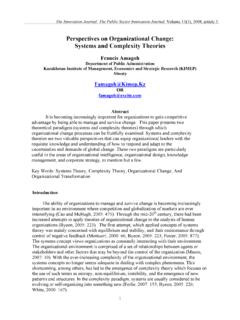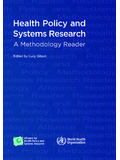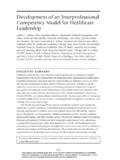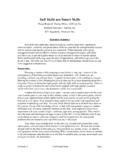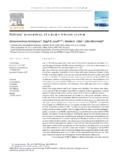Transcription of Innovation in Healthcare Delivery Systems: A Conceptual ...
1 The Innovation Journal: The Public Sector Innovation Journal, Volume 15(1), 2010, Article 2. 1 Innovation in Healthcare Delivery Systems: A Conceptual Framework Vincent K. Omachonu* Department of Industrial Engineering University of Miami Coral Gables, Florida 33124 USA E-mail: *Corresponding Author and Norman G. Einspruch Department of Electrical and Computer Engineering University of Miami Coral Gables, Florida 33124 USA E-mail: The Innovation Journal: The Public Sector Innovation Journal, Volume 15(1), 2010, Article 2.
2 2 Innovation in Healthcare Delivery Systems: A Conceptual Framework Vincent K. Omachonu and Norman G. Einspruch ABSTRACT The Healthcare industry has experienced a proliferation of innovations aimed at enhancing life expectancy, quality of life, diagnostic and treatment options, as well as the efficiency and cost effectiveness of the Healthcare system . Information technology has played a vital role in the Innovation of Healthcare systems. Despite the surge in Innovation , theoretical research on the art and science of Healthcare Innovation has been limited.
3 One of the driving forces in research is a Conceptual framework that provides researchers with the foundation upon which their studies are built. This paper begins with a definition of Healthcare Innovation and an understanding of how Innovation occurs in Healthcare . A Conceptual framework is then developed which articulates the intervening variables that drive Innovation in Healthcare . Based on the proposed definition of Healthcare Innovation , the dimensions of Healthcare Innovation , the process of Healthcare Innovation and the Conceptual framework, this paper opens the door for researchers to address several questions regarding Innovation in Healthcare .
4 If the concept of Healthcare Innovation can be clarified, then it may become easier for health policymakers and practitioners to evaluate, adopt and procure services in ways that realistically recognize, encourage and give priority to truly valuable Healthcare innovations. Lastly, this paper presents 10 research questions that are pertinent to the field of Healthcare Innovation . It is believed that the answers to these and other such questions will hold the key to future advances in Healthcare Innovation research. Key words: Healthcare Innovation , Innovation process Introduction Innovation in Healthcare continues to be a driving force in the quest to balance cost containment and health care quality.
5 Innovation is considered to be a critical component of business productivity and competitive survival [Zaltman, et al., 1973]. Technological innovations present vast opportunities for 1) product Innovation the introduction of new types of goods and services for the external market and 2) process Innovation enhancement of internal production processes for goods and services [Perri 6, 1993]. Product innovations are essential to the life of any organization since they provide the most obvious means for generating incremental revenues [Johne, 1999].
6 Similarly, process Innovation is concerned with improving internal capabilities [Johne and Davies, 2000; Johne, 1999] and safeguarding and improving quality [Johne, 1999]. The Innovation Journal: The Public Sector Innovation Journal, Volume 15(1), 2010, Article 2. 3 In 2005, did a study about the effects of Innovation on a company and they found that, overall revenue growth (78%), customer satisfaction (76%), growth in revenue from new products or services (74%), increased productivity (71%), and earnings/profit margins (68%) were a result of the impact of Innovation efforts.
7 [Jusko, 2008]. Medical science has advanced exponentially during the last half a century. Yet, the paper system has stymied the ability of care givers to access the information vital to the Delivery of care. Patient information is routinely held in static paper storage systems and managed with a silo mentality. Of the $600 billion spent on lab tests each year in the , 70 percent of that money pays for paperwork, says Shanker S. Sastry, Engineering Dean at the University of California, Berkeley, and Director Emeritus of the Center for Information Technology Research in the Interest of Society (CITRIS).
8 Paperwork is prone to costly errors. Sastry argues that huge savings can be realized by more and better use of electronic recordkeeping, employing software that can detect mistakes and issue prompts [Grose, 2008]. When Healthcare providers have to rely on paper records, the sharing of information and the Delivery of care become challenging and often impossible. Without full and secure access to patient records, Healthcare services providers would give up the vital insight provided by the patients health history. The Healthcare industry sits on the hinge of a future in which physicians can instantly share imaging and test results with colleagues in the same building or across the country or continent.
9 Patients should be able to have immediate access to their own records and be able to transmit or carry it from one Healthcare provider to another. Innovation has become a critical capability of all Healthcare organizations [Lansisalmi, et al., 2006]. In addition, new digital information, nanotechnology, semiconductor products, and genetic engineering are revolutionizing health care, making old assumptions invalid and creating unanticipated prospects for Innovation and improvement of existing processes [Govindarajan, 2007]. The last century has produced a proliferation of innovations in the health care industry aimed at enhancing life expectancy, quality of life, disgnostic and treatment options, as well as the efficiency and cost effectiveness of the Healthcare system [Varkey, Horne and Bennet, 2006].
10 These include, but are not limited to, innovations in the process of care Delivery [Varkey and Athyal, 2005], medications, and surgical interventions [Varkey, Horne and Bennet, 2006]. In a study by Fuchs and Sox (Fuchs and Sox, 2001), medications ( , angiotensin-converting enzyme inhibitors, statins, proton pump inhibitors, antidepressants), diagnostic modalities ( , magnetic resonance imaging, computerized tomography scanning, mammography), and procedures ( , balloon angioplasty, coronary artery bypass graft, cataract extraction) made the list of top 10 medical innovations.
